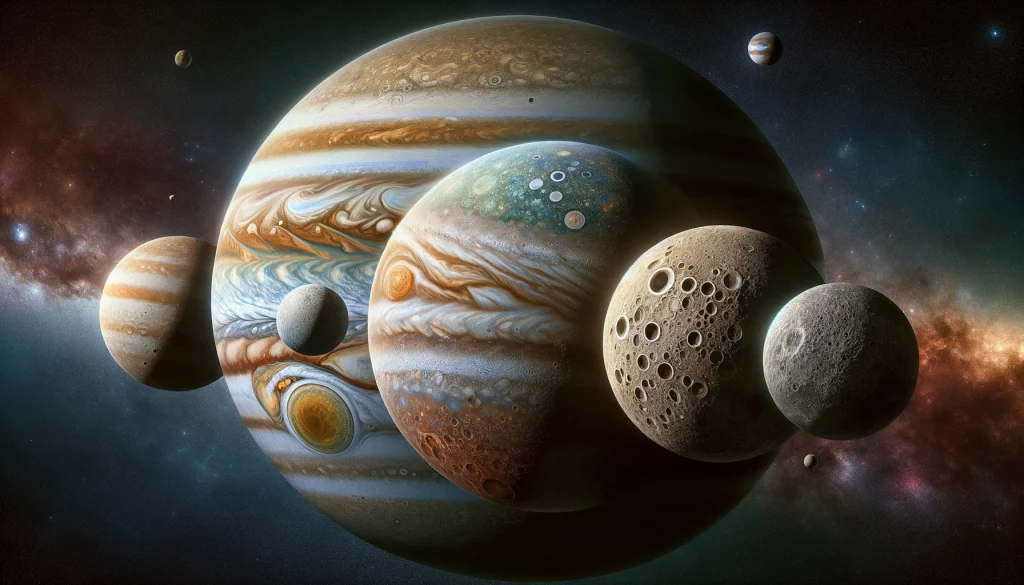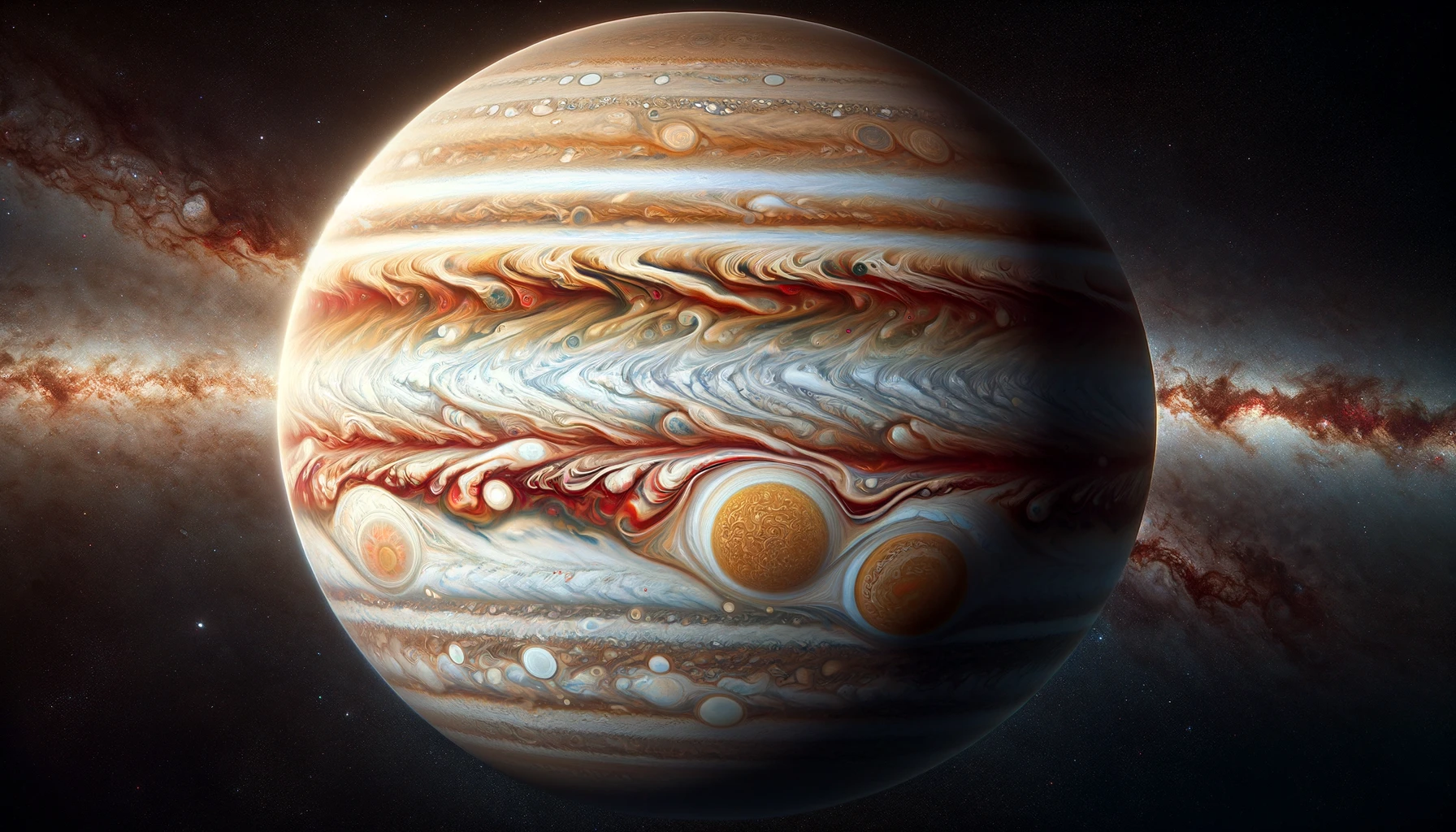Jupiter, the fifth planet from the Sun, reigns supreme as the largest planet in our solar system. Dwarfing all other planets with its immense size, Jupiter casts a long shadow, influencing the celestial neighborhood with its powerful gravity. This gas giant holds a dominant position within the solar system, playing a crucial role in its formation and ongoing dynamics.
A World of Gas: Jupiter’s Composition and Atmosphere
Unlike Earth with its solid ground, Jupiter is a true gas giant. Lacking a defined rocky surface, Jupiter is a swirling mass of gas, primarily hydrogen and helium, similar to the composition of our Sun. This immense atmosphere makes up most of the planet, with its density increasing towards the core.
The swirling gases of Jupiter’s atmosphere create a vibrant and dynamic world. One of the most prominent features is the Great Red Spot, a persistent anticyclonic storm system larger than Earth. This anticyclone has raged for centuries, a swirling mass of red clouds that continues to baffle scientists with its size and longevity.
A Colorful Tapestry: Jupiter’s Cloud Layers and Dynamics
Jupiter’s atmosphere is a far cry from the calm blue expanse we see on Earth. Instead, it’s a vibrant and dynamic tapestry of colorful bands and swirling features. This mesmerizing spectacle is a result of complex atmospheric processes.
The colorful bands we see are actually variations in cloud layers formed due to differences in temperature and pressure across Jupiter’s vast atmosphere. Sunlight interacts with these clouds at different depths, creating the distinctive hues of orange, brown, white, and red that paint the Jovian landscape. Ammonia ice crystals are believed to be responsible for the white clouds, while deeper clouds containing sulfur and phosphorus compounds likely contribute to the red and brown colors.
The beauty of these bands is juxtaposed by the power they hold. Jupiter’s atmosphere is not a still picture; it’s a churning ocean of gas. Powerful winds, reaching speeds of hundreds of kilometers per hour, whip across the planet, creating the swirling features and massive storms that rage within the Jovian atmosphere. The most prominent example is the Great Red Spot, a persistent anticyclone discussed earlier, but numerous other storms and weather systems dance across Jupiter’s vibrant surface.
A Magnetic Giant: Jupiter’s Powerful Magnetosphere
Jupiter’s reign extends beyond its impressive size. It boasts the strongest magnetic field in our solar system, generated by the movement of its electrically charged molten metallic hydrogen core. This immense magnetic field, like a gigantic invisible shield, stretches far beyond the planet itself, creating a vast region called the magnetosphere.
The magnetosphere acts as a barrier, deflecting most of the solar wind, a stream of charged particles emanating from the Sun. However, some energetic particles get trapped within the magnetosphere, interacting with Jupiter’s magnetic field lines and causing them to spiral around the poles. When these energetic particles collide with the atmosphere at the poles, they create breathtaking auroral displays, similar to the northern and southern lights seen on Earth, but on a much grander scale. Jupiter’s auroras are believed to be even more colorful than Earth’s, with vibrant shades of red, green, and yellow dancing across the Jovian sky.
The influence of Jupiter’s magnetic field extends to its moons. The charged particles trapped within the magnetosphere bombard the volcanic moon Io, contributing to its dramatic volcanic activity. The interaction of the magnetic field with the salty water oceans suspected to exist beneath the icy surface of Europa is also a topic of keen scientific interest.
A Family of Moons: Orbiting Jupiter’s Realm
Jupiter is not a solitary giant. It reigns over a vast court of moons, with more than 79 known moons orbiting the gas giant. Of these, the four largest, known as the Galilean moons, hold a special place due to their size and unique characteristics. Discovered by Galileo Galilei in the early 17th century, these moons continue to be a focal point of Jovian exploration.

- Io: The innermost Galilean moon, Io, is the most volcanically active body in our solar system. Its surface is a landscape of volcanoes spewing sulfurous plumes, creating a world sculpted by fire. Scientists believe Io may harbor a vast subsurface ocean of molten rock.
- Europa: Europa, with its icy, cracked surface, is a moon that has captured the imagination of astrobiologists for decades. A vast subsurface ocean of liquid water is suspected to exist beneath the icy shell, making Europa a prime target in the search for extraterrestrial life.
- Ganymede: The largest moon in our solar system, Ganymede, is even bigger than the planet Mercury. Ganymede likely has a metallic core and a subsurface ocean sandwiched between layers of ice. Its thin atmosphere and intriguing internal structure make it a fascinating object for future exploration.
- Callisto: The outermost of the Galilean moons, Callisto, is a heavily cratered world of ice and rock. Scientists believe it may also harbor a subsurface ocean, but unlike Europa, a thicker layer of ice likely separates the surface from any potential ocean.
The exploration of Jupiter’s moons is an ongoing endeavor. Spacecraft missions like Galileo, Juno, and the upcoming Europa Clipper have provided valuable data, and future missions aim to delve deeper. Understanding the geology and potential habitability of these moons is a crucial step in humanity’s quest to understand our place in the universe.
A Ring System Unveiled: Unveiling Jupiter’s Faint Jewelry
While Saturn may be the poster child for planetary rings, Jupiter also sports a ring system, albeit a much fainter and less dramatic one. Unlike Saturn’s bright and icy rings, Jupiter’s rings are composed primarily of dust and debris particles, making them difficult to observe from Earth.
These Jovian rings are far less substantial than their Saturnian counterparts. They are faint and diffuse, spread out in a thin sheet around the planet. The ring system is believed to be comprised of three main components:
- An inner, faint ring: This ring is closest to Jupiter and is made up of microscopic dust particles.
- A broader, main ring: This ring extends outward from the inner ring and contains larger dust particles and some rocky debris.
- An outermost, gossamer ring: This extremely faint ring is the farthest from Jupiter and is likely composed of dust ejected from the moons orbiting within the ring system.
The origin of Jupiter’s rings remains a topic of debate among scientists. One theory suggests they may be the result of collisions between small moons or asteroids within Jupiter’s orbit, with the debris from these impacts grinding down into dust particles. Another possibility is that volcanic activity on Jupiter’s moon Io might play a role in replenishing the ring system with dust.
Despite their faintness, Jupiter’s rings offer valuable insights into the ongoing processes shaping the Jovian system. Studying the rings can help us understand the dust environment around Jupiter and the potential hazards faced by spacecraft venturing into this region.
A Giant’s Formation: Unveiling Jupiter’s Origins
Jupiter’s immense size and dominance within the solar system raise questions about its birth. Scientists believe Jupiter likely formed through the core accretion model, the same process thought to have created our Sun and other planets. This model suggests that during the early days of the solar system, a swirling disk of gas and dust surrounded the young Sun. Within this disk, dust particles clumped together due to gravity, gradually growing larger and denser.
Over millions of years, these clumps accreted more and more material, eventually forming the cores of planets. In Jupiter’s case, its immense size suggests a particularly efficient accretion process. Its strong gravity may have allowed it to gobble up surrounding material at a faster rate than other objects forming in the solar system. This rapid growth is believed to be a key factor in Jupiter’s impressive size.
Jupiter’s gravity continues to play a significant role in the solar system even today. It acts as a kind of celestial shepherd, influencing the orbits of asteroids, comets, and other objects within its vast realm. The Trojan asteroids, which share Jupiter’s orbit, are one example of how Jupiter’s gravitational influence shapes the solar system’s architecture.
Understanding Jupiter’s formation is an ongoing quest. By studying its composition and the properties of its moons, scientists can piece together clues about the early history of the solar system and the conditions that led to the birth of this gas giant. Future space missions may provide even more data, helping us refine our understanding of Jupiter’s formation and its role in the grand story of our solar system.
A Beacon for the Future: Jupiter’s Role in Space Exploration
Jupiter’s influence extends beyond its immediate realm. This gas giant plays a crucial role in our exploration of the outer solar system. Its immense gravity acts as a powerful slingshot for spacecraft. By carefully maneuvering a spacecraft close to Jupiter, scientists can leverage the planet’s gravity to gain a significant boost in speed, propelling them onwards towards distant destinations like Pluto or the Kuiper Belt. This gravitational slingshot technique has been instrumental in numerous successful missions venturing into the deep solar system.
Looking ahead, Jupiter itself and its intriguing moons remain prime targets for future exploration. Missions like the upcoming Europa Clipper, dedicated to studying Europa’s potential ocean and searching for signs of life, are a testament to the ongoing scientific interest in Jupiter’s system. The prospect of life, particularly microbial life in the subsurface oceans of Europa, is a driving force behind this exploration.
Understanding Jupiter is not just about its own story; it offers a broader perspective on planetary formation and evolution. By studying Jupiter’s composition, atmosphere, and moons, we gain insights into the early stages of our solar system’s development. Jupiter serves as a kind of reference point, a massive gas giant that may hold clues to the conditions that led to the formation of planets throughout the galaxy.
In conclusion, Jupiter is more than just a giant in our solar system; it’s a beacon for the future of space exploration. From its role in propelling spacecraft outwards to its potential for harboring life, Jupiter continues to capture our imagination and fuel our scientific curiosity. As we delve deeper into the mysteries of this gas giant and its moons, we unlock a greater understanding of our place in the vast universe.
Beyond the Red Spot: Unveiling Jupiter’s Mysteries
Jupiter, the reigning giant of our solar system, stands out as a world unlike any other. This swirling mass of gas, adorned with colorful bands and a persistent Great Red Spot, dwarfs all other planets with its immense size. Its powerful gravity shapes the solar system, influencing the orbits of celestial bodies and acting as a slingshot for spacecraft venturing into the outer reaches.
Beneath its swirling atmosphere lies a story of formation, with theories suggesting its rapid growth through core accretion processes. Jupiter’s vast magnetosphere shields its moons and creates breathtaking auroral displays. Orbiting this gas giant is a court of moons, with the Galilean moons – Io, Europa, Ganymede, and Callisto – holding particular scientific interest. Europa, with its suspected subsurface ocean, has become a prime target in the search for extraterrestrial life.
Jupiter’s faint ring system, while less prominent than Saturn’s, offers insights into the ongoing processes within the Jovian system. Understanding Jupiter is not just about this single planet; it’s about piecing together the puzzle of our solar system’s formation and evolution. By studying Jupiter, we gain a broader perspective on planetary development and the potential for life beyond Earth.
The exploration of Jupiter and its moons is far from over. Future missions like Europa Clipper promise to unveil more about the potential for life in our cosmic neighborhood. As we continue to unravel the mysteries of this gas giant and its fascinating moons, Jupiter serves as a constant reminder of the wonders and ongoing discoveries that await us in the vast expanse of space.
